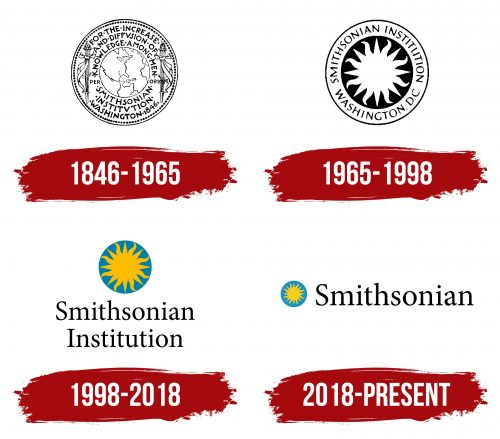In its current form, the Smithsonian logo embodies the sun’s radiance as a symbol of knowledge, illuminating the path for each student on their exciting and challenging research journey and the search for truth. The modern identity stands out for its harmonious blend of beauty and simplicity. While beauty has always been a feature of logos from various eras, minimalism and restraint have peaked in the latest version.
The decorative elements, ornaments, and designs that once adorned the early prototypes of the logo gradually faded away, much like in a painting where the artist’s sketches give way to the purity of lines and simplicity of forms. Today’s logo embodies restraint and professionalism, emphasizing precision, clarity, and minimalism. It presents minimal information, but its delivery is so elegant that it symbolizes the Smithsonian University.
This logo belongs to one of the most renowned educational institutions, serving as a “beacon” of the country’s cultural heritage. It reflects the values the university is founded on: curiosity for knowledge, a drive for intellectual growth, and a thirst for research.
Smithsonian: Brand overview
The British scientist James Smithson left his estate to the United States of America in 1829 to establish an institution “for the increase and diffusion of knowledge.” This is how the Smithsonian Institution’s history began. A man who had never been to the United States made this unique legacy, which shocked and divided American culture.
The transfer of Smithson’s legacy to the United States required several years after his death in 1829. Richard Rush, an American diplomat, was dispatched to England in 1835 to obtain the endowment of more than 500,000 gold sovereigns.
President James Polk signed the legislation creating the Smithsonian Institution on August 10, 1846. With the passage of this statute, one of the world’s biggest museum and research complexes was established.
Renowned physicist Joseph Henry served as the institution’s first secretary. Under his direction, the organization concentrated on scholarly publications and research instead of establishing a museum, as some had suggested.
The first structure, dubbed the “Castle,” was finished in 1855. This Romanesque-style tower, which now serves as the administrative hub, came to represent the organization.
The United States Exploring Expedition’s collection was acquired in 1858, greatly enhancing the institution’s scientific holdings.
The Civil War, which lasted from 1861 to 1865, deeply impacted the activities. Despite obstacles, the organization kept up its work, and its structure even functioned as a shelter during the conflict.
The United States National Museum—now called the National Museum of American History—was founded in 1879 as a division of the institution.
The late 19th and early 20th centuries saw great expansion. The National Gallery of Art, currently the Smithsonian American Art Museum, was founded in 1896, and the National Zoological Park was built in 1889.
The National Museum of Natural History, which houses extensive collections in anthropology, geology, and biology, opened its doors in 1904.
Expansion continued in the 1920s and 1930s. Founded in 1923, the National Air Museum is known as the National Air and Space Museum.
World War II greatly affected the activities. Many employees were called to serve in the armed forces, and certain collections were evacuated for security.
The organization kept growing after the war. The Hirshhorn Museum and Sculpture Garden opened in 1967 after the National Museum of American History did in 1964.
New museums opened in the 1970s and 1980s, such as the National Museum of African Art in 1981 and the National Air and Space Museum in 1976.
The institution expanded in the 1990s and 2000s. Several new museums opened, including the National Museum of African American History and Culture in 2016 and the National Museum of the American Indian in 2004.
In 2001, the opening of the George Gustav Heye Center of the National Museum of the American Indian on the National Mall in Washington, D.C., was an important step in recognizing and conserving Native American culture.
The National Air and Space Museum’s Steven F. Udvar-Hazy Center opened close to Washington Dulles International Airport in 2004, greatly increasing the museum’s ability to show large aircraft and spacecraft.
The institution started a YouTube account in 2006 to increase its online presence and reach a wider audience.
The National Museum of Natural History’s Sant Ocean Hall, which focuses on marine science, opened its doors in 2008.
The organization initiated a digitization project in 2011 to provide researchers and the general public with online access to many of its holdings.
2013 saw several important managerial changes. When David Skorton was named Secretary, the organization underwent several key shifts.
2016, a momentous occasion occurred in American cultural life: the eagerly anticipated opening of the National Museum of African American History and Culture.
The institution started the “Smithsonian Campaign” in 2018 to raise $1.5 billion to fund several initiatives.
The National Museum of the American Latino and the American Women’s History Museum are two new museums the institution announced to open in 2019.
2020 saw the organization actively grow its digital activities, including new online exhibitions and educational programs, despite global obstacles.
The organization honored its long history with several special events and exhibitions to mark its 175th anniversary in 2021.
The Arts and Industries Building reopened in 2022 after renovations with brand-new interactive displays.
The institution was a major player in scientific study throughout this period, especially in astrophysics, anthropology, and natural history.
The organization strengthened its position as a world leader in museums and scientific research by extending its international ties and planning exhibitions and research projects across borders.
Throughout its existence, the institution has been essential to the preservation and study of global and American scientific and cultural legacies. It has developed into a complex of museums and a major research facility that contributes greatly to many scientific disciplines.
As a result, the institution’s history is one of continuous expansion and progress, starting with a modest gift from a British scientist and growing to become the biggest network of museums and research facilities in the world, all while contributing greatly to the preservation and dissemination of knowledge.
Meaning and History
What is Smithsonian?
It is a collection of museums and research institutions run by the U.S. government and known as the Smithsonian Institution. It includes 19 museums, 21 libraries, nine research institutes, and a zoo. It is the world’s largest museum, education, and research complex headquartered in Washington, DC. The Smithsonian Institution has approximately 155 million objects and specimens in its collections, ranging from historical artifacts to scientific specimens. The National Museum of Natural History, the National Air and Space Museum, and the National Museum of American History are just a few of its many museums. A national treasure, the Smithsonian Institution plays an important role in presenting and preserving American and world history.
1846 – 1965
One of the most information-rich university logos was its very first version. This multifaceted symbol had a unique feature: the longer you looked at it, the more information it revealed. It remained relevant for more than 70 years, starting in 1864 when it was first introduced as the symbol of the educational institution. The logo changed the bicentennial celebration of the founder’s birth, but its original charm is still remembered.
The centerpiece of this emblem was a meticulously drawn globe, which left an indelible impression on many generations. On both sides of the globe were unique torches symbolizing the pursuit of knowledge and fundamental education.
The logo also included text elements above and below the globe, enhancing its informational richness. The simplicity and clarity of their content became additional advantages, strengthening the university’s symbolic image for many decades.
1965 – 1998
The new identity’s symbolism was almost completely revised. Replacing the two torches with an image of the sun was deeply meaningful. As a symbol, a torch can be extinguished in difficult circumstances, whereas the sun remains unchanged, an eternal and inexhaustible light source. This sun, present in many logos, carries sacred meaning. In this case, its rays symbolized development and striving towards the future. The white sun on a black background appeared logical and attractive, creating a powerful visual contrast.
The logo also included a textual part — the name of the university. Two placement options for the text were used: around the sun and over it. This is why two versions of the logo can be found in the preserved archives, each of which retains its meaning but presents it differently.
1998 – 2018
The black-and-white palette gave way to bright and saturated colors in the new period. Smithsonian University’s logo acquired a new color scheme, which has been highly praised. Modern graphics and design trends significantly influenced this choice, and the university had significantly raised its status by then.
The sun now dominates the text element, as it should. A golden sun shines at the top of the logo on a blue background, symbolizing the sky’s expanse and the beauty of clouds. Beneath this bright image is the university’s name, occupying an honorable position.
The font for the text element was carefully chosen to emphasize the organization’s importance and stability. Two words begin with capital letters, while the rest of the letters are displayed in elegant lowercase. The letters at the bottom of the logo, anchored on horizontal lines, give the text a sense of solidity and stability, as if they stand on a pedestal, highlighting the unique elegance and dynamism of the entire image.
2018 – today
In 2008, the logo changed: the rising sun, which had previously shone brightly above the university’s name, was shifted to the left. It is now positioned parallel to the name, carrying deep symbolism. The sun represents knowledge, and the university serves as a center providing a wide range of academic programs. Thus, they exist in harmony, enhancing one another.
The new logo is distinguished by its unique presentation characteristics and visual integrity. The letters, aligned in a single row, remain noticeable and easy to read, emphasizing the significance of the university. The bright design on the right draws attention, thanks to the rich blue and yellow tones, which contrast with the simple yet expressive black font on a white background. The font has barely changed compared to the previous version, preserving continuity, and the university’s name continues to look impressive and grand.








